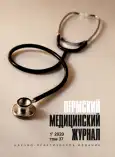Results of surgical treatment of extrahepatic bile duct injuries
- Authors: Kotelnikova L.P.1,2, Burnyshev I.G.1,2, Bazhenova O.V.3, Trushnikov D.V.2
-
Affiliations:
- E.A. Vagner Perm State Medical University
- Perm Regional Clinical Hospital
- Perm Regional Hospital
- Issue: Vol 37, No 1 (2020)
- Pages: 63-72
- Section: Clinical studies
- URL: https://journals.rcsi.science/PMJ/article/view/18988
- DOI: https://doi.org/10.17816/pmj37163-72
- ID: 18988
Cite item
Full Text
Abstract
Aim. To evaluate the short-and long-term outcomes after surgical repair of iatrogenic lesions of extrahepatic bile ducts depending on the timing of diagnosis in conditions of specialized clinic.
Materials and methods. Our study involved a retrospective analysis of 159 patients who were treated for iatrogenic lesions of extrahepatic bile ducts during 1987-2017. These patients were divided into two groups depending on the timing of surgical treatments: early biliary reconstruction (< 5 days after bile duct transection) and late biliary reconstruction (> 5 days post-transection). These groups were compared on the basis of postoperative morbidity and long-term outcomes.
Results. Following laparoscopic cholecystectomy, 2 patients received endoscopic retrograde stents due to bile leakage from the cystic ducts, and 14 patients underwent hepaticocholedochostomy using Ker drainage. The incidence of bile leakage was observed in 14. 3 % of cases during the early post-operative period, strictures appeared in 28.6 % of cases. Hepaticojejunostomy was performed in 91 cases: in 62 – with stents and in 29 – without stents. Bile leakage was observed in 17.6 % of cases, and strictures – in 19.8 % of cases. Our statistical analyses revealed no significant differences between the two groups (i.e., early and late timing of surgical treatment) in the rates of bile leakage and strictures. The extent of surgeon’s experience in bile surgery significantly correlated with positive outcomes.
Conclusions. Endoscopic retrograde stent proved to be an effective and fast solution in cases of bile leakage from cystic ducts following laparoscopic cholecystectomy. Although it is preferable to perform reconstructive surgeries within the first five days after bile duct injury, our results indicated that in the presence of external bile fistula without peritonitis and severe cholangitis, reconstructive surgery can be performed in specialized surgical departments later than 5 days with satisfactory results.
Full Text
##article.viewOnOriginalSite##About the authors
L. P. Kotelnikova
E.A. Vagner Perm State Medical University; Perm Regional Clinical Hospital
Author for correspondence.
Email: splaksin@mail.ru
доктор медицинских наук, профессор, заведующая кафедрой хирургии с курсом сердечно-сосудистой хирургии и инвазивной кардиологии
Russian Federation, PermI. G. Burnyshev
E.A. Vagner Perm State Medical University; Perm Regional Clinical Hospital
Email: nfperm@mail.ru
кандидат медицинских наук, заведующий 2-м хирургическим отделением
Russian Federation, PermO. V. Bazhenova
Perm Regional Hospital
Email: katrina280@yandex.ru
врач-хирург
Russian Federation, v. KultaevoD. V. Trushnikov
Perm Regional Clinical Hospital
Email: hir.fpk159@yandex.ru
врач-эндоскопист
Russian Federation, PermReferences
- Белеков Ж.О., Джапиев У.Х., Маманов Н.А. Билиодигестивная хирургия ятрогенных повреждений внепеченочных желчных путей. Клиническая хирургия Казахстана. 2015; 4 (38): 37–41.
- Булдаков В.В. Профилактика ранних послеоперационных осложнений и рубцовых стриктур при высоких билиарных реконструкциях: автореф. дис. … канд. мед. наук. 2011; 21.
- Гальперин Э.И., Чевокин А.Ю., Дюжева Т.Г. Хирургическое лечение и классификация «свежих» повреждений желчных протоков. Актуальные проблемы гепатопанкреатобилиарной хирургии: материалы XXI Международного конгресса Ассоциации гепатопанкреатобилиарных хирургов стран СНГ 9–12 сентября. Пермь 2014; 119.
- Гальперин Э.И., Чевокин А.Ю. «Свежие» повреждения желчных протоков. Хирургия. Журнал им. Н.И. Пирогова 2010; 10: 4–10.
- Гальперин Э.И., Дюжева Т.Г., Ахаладзе Г.Г., Егоров В.И., Жигалова С.Б., Карагюлян С.Р., Котовский А.Е., Мусин Р.А., Чевокин А.Ю., Шерцингер А.Г. Лекции по гепатобилиарной хирургии. М.: Видар М 2011; 536.
- Горохова А.А., Хмара М.Б., Козлов В.В. Лечение ятрогенных повреждений гепатикохоледоха. Бюллетень медицинских интернет-конференций 2017; 7 (6): 1338–1341.
- Охотников О.И., Григорьев С.Н., Яковлева М.В. Рентгенохирургия повреждений внепеченочных желчных путей. Анналы хирургической гепатологии, 2015; 20 (4): 68.
- Рыбачков В.В., Раздрогин В.А., Герасимовский Н.В., Кирилюк А.А., Аносенко С.А., Сайгушев А.В., Шевердов А.П., Попов А.Е., Филатов М.С. К вопросу лечения ятрогенных повреждений внепеченочных желчных путей. Вестник экпериментальной и клинической хирургии 2012; 5 (4): 705–707.
- Третьяков А.А., Каган И.И., Неверов А.Н., Петров С.В., Кузнецов И.К. Реконструктивная хирургия желчных путей: проблемы и пути решения (обзор литературы). Оренбурский медицинский вестник. Том II 2012; 3 (7): 40–45.
- Третьяков А.А., Каган И.И. Микрохирургическая техника в реконструктивной хирургии внепеченочных желчных протоков. Медицинский альманах 2008; 76–78.
- Федоров И.В., Славин Л.Е., Чугунов А.Н. Повреждение желчных путей при лапароскопической холецистэктомии. М. 2003; 118.
- Хоронько Ю.В., Ермолаев А.Н. Спорные вопросы при лечении ятрогенных повреждений внепеченочных желчных путей и их последствий: варианты решений. Медицинский вестник Юга России 2014; 2: 96–99.
- Calvete J., Sabater L., Camps B., Verdu A., Gomez-Portilla A., Martin J., Torrio M.A., Flor B., Cassinello N., Lledo S. Bile duct injury during laparoscopic cholecystectomy: myth or reality of the learning curve? Surg Endosc 2000; 14 (2): 608–611.
- Felekouras E., Petrou A., Neofytou K., Moris D., Dimitrokallis N., Bramis K., Griniatsos J., Pikoulis E., Diamantis T. Early and delayed intervention for bile duct injuries following laparoscopic cholecystectomy? A dilemma looking for an answer. Gastroenterol Res Pract 2015; 104235. Published online 2015 Feb 2, available at: http://dx.doi.org/10/1155/2015/104235.
- Hajjar N.A., Tomus C., Mocan L., Mocan T., Graur F., Lancu C., Zaharie F. Management of bile duct unjuries following laparoscopic cholecystectomy: long-tern ourcome and risk factors influencing biliary reconstraction. Chirurgia (Bucur) 2014; 109 (4): 493–499.
- Kukar M., Wilkinson N. Surgical Management of bile duct strictures. Indian J Surg 2015; 77 (2): 125–132. doi: 10.1007/s12262-013-0972-7
- Stilling N.M., Fristrup C., Wettergren A., Ugianskis A., Nygaard J., Holte K., Bardram., Sall M., Mortensen M.B. Long-term outcome after early repair of iatrogenic bile duct injury. HPB (Oxford) 2015; 15 (5): 394–400. doi: 10.1111/hpb.12374
- Thompson C.V., Saad N., Quazi R.R., Darcy M.D., Picus D.D., Menias Ch.O. Management of iatrogenic bile duct injuries: role of intervention radiologist. Radiologist 2013; 33 (1): 117–134. DOI: 101148/rg.331125044
Supplementary files








